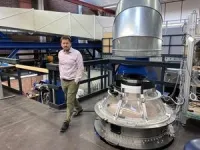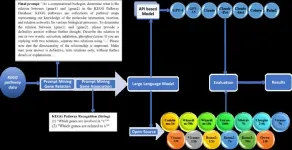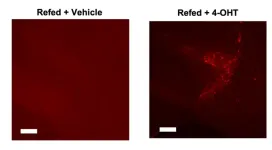(Press-News.org) The possibility of hydrogen-powered flight means greater opportunities for fossil-free travel, and the technological advances to make this happen are moving fast. New studies from Chalmers University of Technology, in Sweden, show that almost all air travel within a 750-mile radius (1200 km) could be made with hydrogen-powered aircraft by 2045, and with a novel heat exchanger currently in development, this range could be even further.
“If everything falls into place, the commercialisation of hydrogen flight can go really fast now. As early as 2028, the first commercial hydrogen flights in Sweden could be in the air," says Tomas Grönstedt, Professor at Chalmers University of Technology, and Director of the competence centre TechForH2* at Chalmers.
Some of these technological advances can be seen inside the Chalmers wind tunnels, where researchers test airflow conditions in cutting edge facilities. Here, more energy-efficient engines are being developed that pave the way for safe and efficient hydrogen flight for heavy-duty vehicles.
Future of short-range hydrogen aviation for Nordics
For hydrogen-powered aviation, short and medium-range flights are the closest to being realised. A recently published study from Chalmers shows that hydrogen-powered flights have the potential to meet the needs of 97 percent of all intra-Nordic flight routes and 58 percent of the Nordic passenger volume by 2045.
For this study, the researchers assumed a maximum flight distance of 750 miles and the use of an existing aircraft model adapted for hydrogen power. The study, led by doctoral student Christian Svensson in Tomas Grönstedt's research group, also showcased a new fuel tank that could hold enough fuel, was insulated enough to hold the super-cold liquid hydrogen and at the same time was lighter than today's fossil-based fuel tank systems.
Novel heat exchangers for better fuel consumption
Heat exchangers are a vital part of hydrogen aviation, and they are a key part of the technological advancements taking place. To keep the fuel systems light weight, the hydrogen needs to be in liquid form. This means that the hydrogen is kept supercool in the aircraft, typically around -250 degrees Celsius. By recovering heat from the hot exhausts of the jet engines, and by cooling the engines in strategic locations they become more efficient. To transfer the heat between the supercool hydrogen and the engine, novel types of heat exchangers are needed.
To meet this challenge, researchers at Chalmers have been working for several years to develop a completely new type of heat exchanger. The technology, which is now patent pending by partner GKN Aerospace, takes advantage of hydrogen's low storage temperature to cool engine parts, and then uses waste heat from the exhaust gases to preheat the fuel several hundred degrees before it is injected into the combustion chamber.
"Every degree increase in temperature reduces fuel consumption and increases range. We were able to show that short- and medium-haul aircraft equipped with the new heat exchanger could reduce their fuel consumption by almost eight percent. Considering that an aircraft engine is a mature and well-established technology, it is a very good result from a single component," says Carlos Xisto, Associate Professor at the Division of Fluid Mechanics at Chalmers, and one of the authors of the study.
The researchers also note that with more optimisation, this type of heat exchanger technology in a regular Airbus A320 commercial aircraft could provide an improved range of up to ten percent, or the equivalent of the Gothenburg-Berlin route (approximately 450 miles).
Sweden pledges big investments, despite challenges
The work to develop solutions for hydrogen aviation of the future is taking place on a broad front, with governments, universities and private companies working together. In Sweden, the innovation cluster, Swedish Hydrogen Development Centre (SHDC), brings together key players, including industry leaders and experts from academia. At a recent SHDC seminar, researchers from Chalmers presented their work and several commercial companies testified to major investments in hydrogen flights in the coming years. Whilst the technology is well advanced, the challenges lie rather in the large investments required, and in developing infrastructure, business models and partnerships to be able to produce, transport and store the hydrogen so that the transition to hydrogen flight is possible. A total transition is expected to require around 100 million tonnes of green hydrogen annually.
"There are industry expectations that 30–40 percent of global aviation will be powered by hydrogen by 2050. It is likely that for a number of years to come, we will need a mix of aircraft that run on electricity, less environmentally harmful e-jet fuel and hydrogen. But every aircraft that can be powered by hydrogen from renewable energy reduces carbon dioxide emissions," says Tomas Grönstedt.
Within TechForH2, there are good conditions to take on the hydrogen challenge, and with a budget of SEK 162 million (equivalent USD 15.5 million), the competence centre can contribute to the development of a number of different research areas that link hydrogen and heavy transport.
about the new studies:
Future Nordic aviation needs can be met by hydrogen
Heat exchange promising technology for hydrogen-powered air traffic
More about the scientific articles
The article Hydrogen fuel cell aircraft for the Nordic market has been published in the International Journal of Hydrogen Energy and is written by Christian Svensson, Amir A.M Oliviera and Tomas Grönstedt. The researchers are active at Chalmers University of Technology and the Federal University of Santa Catarina in Brazil.
The research has been funded by the Chalmers-led competence center TechForH2, through grants from the Swedish Energy Agency and the participating partners Volvo, Scania, Siemens Energy, GKN Aerospace, PowerCell, Oxeon, RISE, Stena Rederier AB, Johnsson Matthey, Insplorion, and Chalmers.
The scientific article Compact heat exchangers for hydrogen-fueled aero engine intercooling and recuperation has been published in the journal Applied Thermal Engineering and is written by Alexandre Capitao Patrao, Isak Jonsson, Carlos Xisto, Anders Lundbladh and Tomas Grönstedt. The authors are active at Chalmers University of Technology and at GKN Aerospace Sweden.
The technology has been developed within the EU project ENABLEH2 and the PATH project, which was funded by Chalmers' Transport Area of Advance. The projects ran between 2018-2022, and then the infrastructure was constructed that was then used to test new engine components and make simulations. At Chalmers' TechForH2 centre, research is underway to further develop the technology.
The research has also received support from the EU programme Horizon 2020 and the Swedish Research Council.
More about TechForH2
TechForH2 is a competence centre for multidisciplinary hydrogen research with the overall aim of developing new technology in hydrogen propulsion for heavier vehicles as an important step in the transition to a fossil-free transport system.
TechForH2 is established by Chalmers University of Technology, Sweden, and is a joint venture together with Rise, Volvo, Scania, Siemens Energy, GKN Aerospace, PowerCell, Oxeon, Insplorion, Johnson Matthey and Stena.
With funding from Chalmers University of Technology, the Swedish Energy Agency and the centre's partners, the centre's total budget amounts to almost SEK 162 million over a five-year period in a first phase, with the possibility of extension for another five years.
The centre conducts research in a number of areas, such as the development of materials, production, heat management, fuel cells, vehicle systems, sensors, safety and a number of societal aspects of a transition to hydrogen operation of heavy transport.
about TechForH2 at Chalmers.
More about hydrogen and hydrogen flight:
Hydrogen, H2, is an invisible, odorless, volatile gas that liquefies at about -250 degrees Celsius (20 Kelvin).
If the hydrogen is produced using renewable energy, it is free of carbon dioxide emissions. This is known as ‘green hydrogen’.
Hydrogen flights can be powered either electrically, using fuel cells that convert the hydrogen into electricity through catalysis, or with jet engines, where the hydrogen is burned in a gas turbine.
Hydrogen contains more energy per kilogramme than today's kerosene, and also has the advantage that the residual product of combustion is mainly water vapour.
The gas is highly flammable if mixed with air, which is why high-efficiency sensors are necessary.
In industry, hydrogen is currently used in the production of, for example, fossil-free steel.
For more information, please contact:
Tomas Grönstedt, Professor, Division of Fluid Mechanics, Department of Mechanics and Maritime Sciences, Chalmers University of Technology, Sweden, Director of the competence centre TechForH2, tomas.gronstedt@chalmers.se, +46 31 772 14 55
Carlos Xisto, Associate Professor, Division of Fluid Mechanics, Department of Mechanics and Maritime Sciences, Chalmers University of Technology, Sweden, carlos.xisto@chalmers.se, +46 31 772 14 58
Both the researchers speak English, and Carlos Xisto also speaks Portuguese, and they may be available for live and pre-recorded interviews.
END
Hydrogen flight looks ready for take-off with new advances
2024-07-11
ELSE PRESS RELEASES FROM THIS DATE:
Same workout, different weight loss: Signal molecule versions are key
2024-07-11
Some people lose weight slower than others after workouts, and a Kobe University research team found a reason. They studied what happens to mice that cannot produce signal molecules that respond specifically to short-term exercise and regulate the body’s energy metabolism. These mice consume less oxygen during workouts, burn less fat and are thus also more susceptible to gaining weight. Since the team found this connection also in humans, the newly gained knowledge of this mechanism might provide a pathway for treating obesity.
It is well known that exercise leads to the ...
Trained peers are as effective as clinical social workers in reducing opioid overdose, new trial finds
2024-07-11
In Rhode Island, USA, over one in four emergency department (ED) patients at high risk of overdose has a non-fatal opioid overdose in the 18 months post-discharge. A parallel, two-arm, randomized controlled trial conducted in Rhode Island of over 600 ED patients at high risk of opioid overdose found that support from a peer recovery support specialist (a trained support worker with lived experience of addiction) was as effective in reducing opioid overdose as support from a licensed clinical social worker. In other words, interviewing and intervention techniques informed by lived ...
Study: Algorithms used by universities to predict student success may be racially biased
2024-07-11
Washington, July 11, 2024—Predictive algorithms commonly used by colleges and universities to determine whether students will be successful may be racially biased against Black and Hispanic students, according to new research published today in AERA Open, a peer-reviewed journal of the American Educational Research Association. The study—conducted by Denisa Gándara (University of Texas at Austin), Hadis Anahideh (University of Illinois Chicago), Matthew Ison (Northern Illinois University), and Lorenzo Picchiarini (University of Illinois Chicago)—found ...
Comprehensive evaluation of large language models in mining gene relations and pathway knowledge
2024-07-11
Understanding complex biological pathways, such as gene-gene interactions and gene regulatory networks, is crucial for exploring disease mechanisms and advancing drug development. However, manual literature curation of these pathways cannot keep pace with the exponential growth of discoveries. Large-scale language models (LLMs) trained on extensive text corpora contain rich biological information and can be leveraged as a biological knowledge graph for pathway curation.
Recently, Quantitative Biology published a study titled "A Comprehensive ...
Researchers pinpoint brain cells that delay first bite of food
2024-07-11
LA JOLLA, CA—Do you grab a fork and take a first bite of cake, or say no and walk away? Our motivation to eat is driven by a complex web of cells in the brain that use signals from within the body, as well as sensory information about the food in front of us, to determine our behaviors. Now, Scripps Research scientists have identified a group of neurons in a small and understudied region of the brain—the parasubthalamic nucleus (PSTN)—that controls when an animal decides to take a first bite of food.
In the study, published in Molecular Psychiatry on July 4, 2024, the team of scientists set out to selectively manipulate a group of PSTN cells that dial up their ...
With spin centers, quantum computing takes a step forward
2024-07-11
RIVERSIDE, Calif. -- Quantum computing, which uses the laws of quantum mechanics, can solve pressing problems in a broad range of fields, from medicine to machine learning, that are too complex for classical computers. Quantum simulators are devices made of interacting quantum units that can be programmed to simulate complex models of the physical world. Scientists can then obtain information about these models, and, by extension, about the real world, by varying the interactions in a controlled way and measuring the resulting behavior of the quantum simulators.
In a paper published in Physical Review B, a UC Riverside-led research team ...
Scientists release new research on planted mangroves’ ability to store carbon
2024-07-11
U.S. Forest Service ecologists and partners published new findings on how planted mangroves can store up to 70% of carbon stock to that found in intact stands after only 20 years.
Researchers have long known that mangroves are superstars of carbon absorption and storage. But until now, limited information existed on how long it took for carbon stored in planted mangroves to reach levels found in intact mangroves.
“About ten years ago, Sahadev Sharma, then with the Institute of Pacific Islands Forestry, and I discovered that 20-year-old mangrove plantations in Cambodia had carbon stocks comparable to those of intact forests,” ...
New immune cell therapy benefits laboratory models of ALS and has some positive results in an individual with the disease
2024-07-11
Immune system dysregulation and elevated inflammation contribute to the development of the fatal neurodegenerative condition amyotrophic lateral sclerosis (ALS), also known as Lou Gehrig's disease.
In new research published in The FASEB Journal, repeated infusions of certain immune cells delayed ALS onset and extended survival in mice, and also reduced markers of inflammation in an individual with the disease. The work was conducted by investigators at Massachusetts General Hospital, a founding member of the Mass General ...
Trial of cell-based therapy for high-risk lymphoma leads to FDA breakthrough designation
2024-07-11
CAR-T cell therapy, which targets a specific protein on the surface of cancer cells, causes tumors to shrink or disappear in about half of patients with large B-cell lymphoma who haven’t experienced improvement with chemotherapy treatments.
But if this CAR-T treatment fails, or the cancer returns yet again — as happens in approximately half of people — the prognosis is dire. The median survival time after relapse is about six months.
Now, a phase 1 clinical trial at Stanford Medicine ...
Major trial looks at most effective speech therapy for people with Parkinson’s disease
2024-07-11
A major clinical trial, led by experts at the University of Nottingham, has shown the Lee Silverman Voice Treatment (LSVT LOUD®) is more effective than the current speech and language therapy provided by the NHS, when treating patients with Parkinson’s disease (PD).
The results of the NIHR HTA funded trial, which are published today in the BMJ, showed that LSVT LOUD® was more effective at reducing the participant’s reported impact of voice problems than no speech and language therapy, as well as the NHS delivered speech and language therapy.
The trial was led by experts from the Universities of Nottingham and Birmingham, ...







